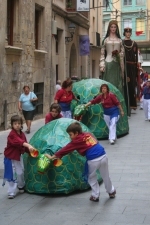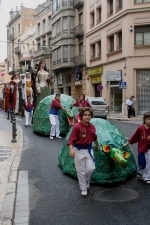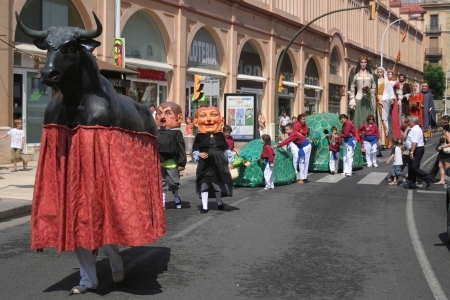
History
Amades wrote about the city's Cucafera beast in his book “Costumari Català” (Record of Catalan Customs), saying: “To this day, the City of Tortosa has preserved some notable examples of this mythological animal, of a different species that is difficult to classify, although they bear somewhat of a resemblance to tortoises. They are known as Cuquesferes. There are three of them: a large one that seems to be the mother, and two small ones, which are her children. A special device enables them to open and close their mouths. When they do so, their teeth make a loud crunching sound that scares children, who have been told that each Cucafera eats thirteen cats and three live children each day”.
The record of the Cucafera is scarcely known yet noteworthy, not only because its existence dates back to the 16th Century (having achieved widespread notoriety by the year 1600), but also because of the description that the poet gives us, revealing that the beast is related to dragons, rather than comparisons with tortoises, as Amades believed, as well as the assertion of its ferocity (it can’t escape its roots), spitting fireworks and bangers out of its mouth.

The Cucafera's head seems to have been pulled from a gargoyle from the Cathedral, with the body of a stone beast being brought to life by magic. You only have to look at it to know that it is Gothic in origin.
Legend
A long time ago, a young man came to Tortosa. This man was so tall he stood out from the locals. His name was Rufolet and had come from a faraway land to rescue a princess called Rubí, who had been placed under a spell by a sorcerer and hidden in a cave near Tortosa.
Leaving the city through the Remolins gate, he headed towards the Bassa de Xaco pool. Along the way, he heard some loud screams and, as he approached a pool, he saw a sprite drowning. Taking two steps, he entered the pool and pulled out the sprite. To show his gratitude, the sprite took Rufolet to the cave where Rubí was hidden and warned him of the presence of a strange beast with fire coming out of its eyes and froth out of its mouth. The sprite told Rufolet that the beast, known as the Cucafera, would lose its powers and strength if you cut off its tails and ears

As he entered the cave to rescue Rubí, the Cucafera appeared, ready to attack. The sprite, whose name was Xaco, and his friends Pepo, Guari, Canasta, Xanca, Moixina and Mut had sharpened Rufolet’s sword very well, and he managed to cut off the Cucafera’s tail and ears in a single blow, turning it into a docile beast.
Afterwards, Rufolet, Rubí, the sprites and the Cucafera all returned to Tortosa. As they reached the city, they came across musicians with dolçaina flutes and drums on their way to play at the Corpus Christi procession. All together they made a strange entourage which entranced all the citizens. Since then, they all take part in the Corpus Christi procession, but not in person, as they all went to Rufolet’s country and have still not come back.
THE CUCAFERA OF TORTOSA AND ITS COURT OF BEASTS
There has always been a lot of mystery about the origins of the beasts that head the traditional processions in our towns and cities, particularly in the case of Corpus Christi. However, they have become so popular that they now accompany any event related to local celebrations.
In Tortosa, we have the following beasts: the Cucafera, who has become a fully-fledged member of the community and has escaped from representing the processions and craftsmen’s confreries (First from the Fishermen’s Guild and then from the Festival of the Virgin of the Ribbon), to roam freely among the crowds at any public celebration. It has ended up becoming more lovable than scary. It seems to have taken the advice of the Priest of Vallfogona:
Strive to atone by
being, from this point onwards,
a Cucafera for good.
And the Lord will bless you.

The best idea to proceed step by step, following the correct order. The Cucafera’s head seems to have been pulled from a gargoyle from the Cathedral, with the body of a stone beast being brought to life by magic. You only have to look at it to know that it is Gothic in origin.
Amades wrote about the city’s Cucafera beast in his book “Costumari Català” (Record of Catalan Customs), saying: “To this day, the City of Tortosa has preserved some notable examples of this mythological animal, of a different species that is difficult to classify, although they bear somewhat of a resemblance to tortoises. They are known as Cuquesferes. There are three of them: a large one that seems to be the mother, and two small ones, which are her children. A special device enables them to open and close their mouths. When they do so, their teeth make a loud crunching sound that scares children, who have been told that each Cucafera eats thirteen cats and three live children each day”.
I have no information about their diet. However, with regard to their ferocious manifestations and other aspects which we will come to, we have a reliable testimony in the romance of the eminent doctor Vicenç Garcia, the Rector of Vallfogona, who stated that “the Cucafera of Tortosa serves the fishermen’s confrerie in the city and, taking part in the procession of Corpus Christi, it disconcerts with a knock of its snout, six flutes and a portable organ".
The record of the Cucafera is scarcely known yet noteworthy, not only because its existence dates back to the 16th Century (having achieved widespread notoriety by the year 1600), but also because of the description that the poet gives us, revealing that the beast is related to dragons, rather than comparisons with tortoises, as Amades believed, as well as the assertion of its ferocity (it can’t escape its roots), spitting fireworks and bangers out of its mouth.
As for the children, the Priest of Vallfogona gives us a record of their birth, which, according to him, was eventful and resulted in the birth of two males:
From all the twisting,
Bocaram’s belly
Gave forth the baby Cucaferas
The size of fifteen-year-old boys.
I would like to turn now to the other beasts that used to take part in the procession, which have now vanished from our folklore without trace, but which we can now retrieve from obscurity thanks to the Priest of Vallfogona: “The eagle, ox and horses".
The designs are approximate, taken from similar beasts found in other towns around Catalunya, as collected by J. Amades in his compilation of Catalan customs. However, Amades did not record the existence of these zoological species in Tortosa. We would imagine that they would not be very different from other beasts that he recorded, although it would be extremely interesting to discover what variations they may have had in our city.
According to the French archaeologist, C. Cahier, Amades states that the eagle belongs to the realm of “mystical zoology”: animals chosen to represent virtues. The eagle stands for justice. However, Josep Pijoan believes that our eagle may symbolize the Crown of Aragon, as it is Ghibelline in origin and it was the emblem of this faction. Only cities can have the eagle. The fact that it appears wearing a crown seems to give strength Pijoan’s position because it gives the impression of being a heraldic eagle. Being our city’s eagle, it seems right to design it in line with the second theory: the heraldic eagle of the City de Tortosa, belonging to the Crown of Aragon, so closely linked to the Count and King as was the case.
As for the ox, Amades puts forward three possible origins: the ox of Saint Luke, the ox at the birth of Christ and the ox in relation to a livestock ceremony or some such, lost in the history of the first Iberians.
Another animal which takes part in the festivities is the horse, the origins of which do not seem to go beyond the premise of simulating a battle between a group of Turks and Christian knights: This premise is comprised of a group of men pretending to ride a small cardboard horse which is attached to their bodies and suspended in mid-air.